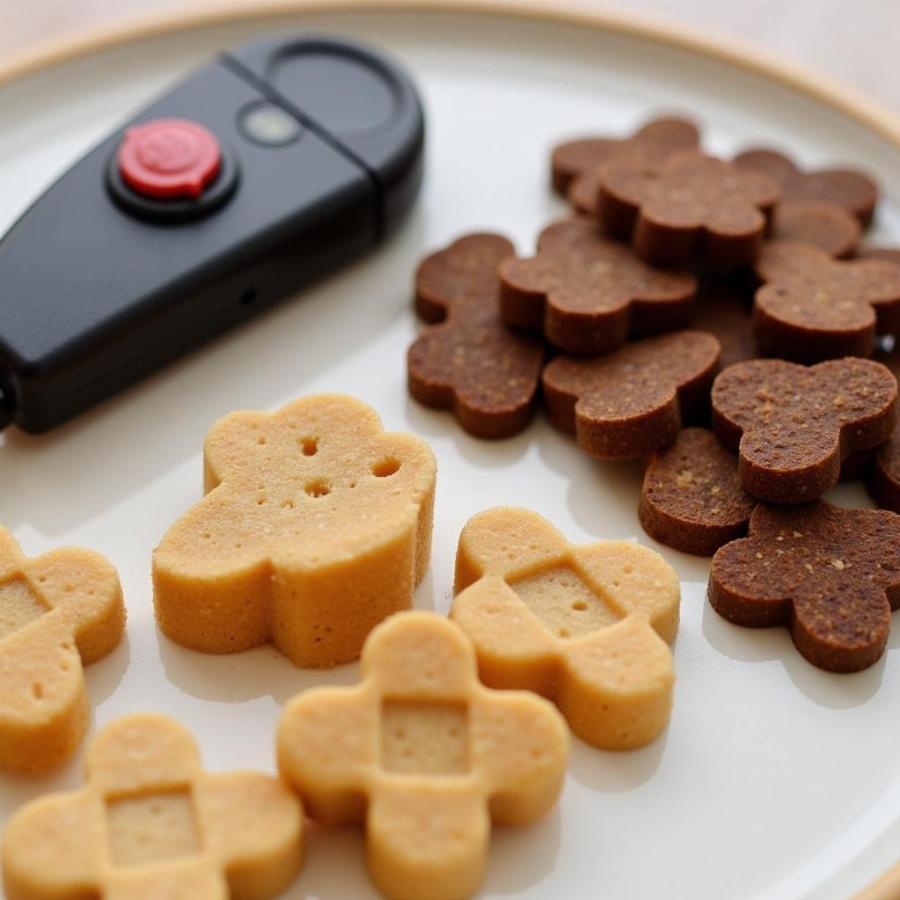Spot on dog training, also known as marker training, is a positive reinforcement technique that focuses on clear communication and immediate feedback. This method uses a distinct “marker” – often a clicker or a specific word like “yes” – to pinpoint the exact moment your dog performs the desired behavior. This precise timing allows for faster learning and strengthens the bond between you and your furry friend.
Why Choose Spot On Dog Training?
Spot on dog training is highly effective because it eliminates the confusion traditional methods can sometimes create. Instead of reacting to your dog’s mistakes, you’re proactively rewarding their successes. This encourages your dog to repeat the desired behavior, making training sessions more enjoyable for both of you.
Tools for Spot On Success
 Dog training clicker and treats
Dog training clicker and treats
- Clicker: This small, handheld device emits a distinct clicking sound that serves as your marker signal.
- Treats: Choose high-value, small treats that your dog finds irresistible. These will serve as your positive reinforcement.
Getting Started with Spot On Dog Training
- Charge the Clicker (Conditioning): Begin by associating the clicker with something positive. Click the clicker and immediately give your dog a treat. Repeat this several times until your dog clearly anticipates the treat after hearing the click.
- Introduce the Cue: Once your dog understands that the click equals a reward, you can start introducing cues for specific behaviors. For example, say “sit” and the moment your dog’s rear touches the ground, click and treat.
- Practice and Consistency: Like any skill, spot on dog training requires practice and consistency. Keep your training sessions short and engaging, and remember to always end on a positive note.
Benefits Beyond Basic Commands
Spot on training isn’t just for basic commands like sit, stay, or come. This versatile method can be used to:
- Address Behavioral Issues: From jumping to excessive barking, spot on training can help redirect unwanted behaviors by rewarding alternative, desirable ones.
- Build Confidence: The clear communication and positive reinforcement in spot on training fosters a trusting and confident relationship between you and your dog.
- Unlock Your Dog’s Potential: This method can be used to teach tricks, agility courses, and even more complex tasks, allowing you to explore your dog’s full potential.
Troubleshooting Tips
- Timing is Key: The clicker or marker word should occur at the exact moment the desired behavior happens. If your timing is off, your dog might not make the association correctly.
- Stay Patient: Every dog learns at their own pace. Be patient, stay positive, and celebrate the small victories.
- Seek Professional Help When Needed: If you’re struggling with spot on training or encountering specific challenges, don’t hesitate to seek guidance from a certified professional dog trainer.
Spot On Success Starts with You
Mastering spot on dog training is an investment in your relationship with your canine companion. It’s a journey of understanding, communication, and mutual respect. With dedication and consistency, you’ll be amazed at what you and your dog can achieve together.
Expert Insight from Sarah Williams, Certified Dog Trainer:
“Spot on training empowers owners to communicate effectively with their dogs, building a foundation of trust and understanding. It’s incredibly rewarding to witness the ‘aha’ moment when a dog grasps a new concept using this method.”
Frequently Asked Questions about Spot On Dog Training
Q: Can I use a word instead of a clicker?
A: Absolutely! Many owners prefer using a verbal marker like “yes” or “good.” The key is to choose a word you don’t use often in regular conversation and to say it with consistent intonation.
Q: Is spot on training suitable for puppies?
A: Yes, spot on training is highly effective for puppies. Start with short, fun sessions and gradually increase the complexity as your puppy grows.
Q: My dog isn’t responding to the clicker. What should I do?
A: Ensure your dog has been properly conditioned to the clicker. If they still don’t respond, try a different type of clicker or marker word. You might also need to experiment with different types of treats to find what motivates your dog the most.
Q: Can spot on training be used with older dogs?
A: Absolutely! While older dogs might learn at a slightly slower pace, they can certainly benefit from the clarity and positive reinforcement of spot on training.
Q: What if my dog starts offering the behavior without the cue?
A: This is a good sign that your dog is understanding the concept! Start incorporating a hand signal or a verbal cue to formalize the behavior.
Ready to Explore More Dog Training Tips?
Check out these related articles:
- Salty Dog Charters: Discover dog-friendly adventures and create lasting memories with your furry friend.
- Dog Beach Asbury Park NJ: Find the perfect off-leash haven for your water-loving pup.
- Dog is Peeing in the House All of a Sudden: Understand the potential causes and solutions for indoor accidents.
- Indoor Dog Pee Area: Create a designated potty zone for your pup, especially during those times when outdoor access is limited.
About Beaut Dogs
Beaut Dogs is your trusted source for all things dog-related, offering expert advice, tips, and resources to help you provide the best possible care for your canine companion. For personalized support, reach out to our team at [email protected]. We’re here to help you navigate the wonderful world of dog ownership with confidence and joy.